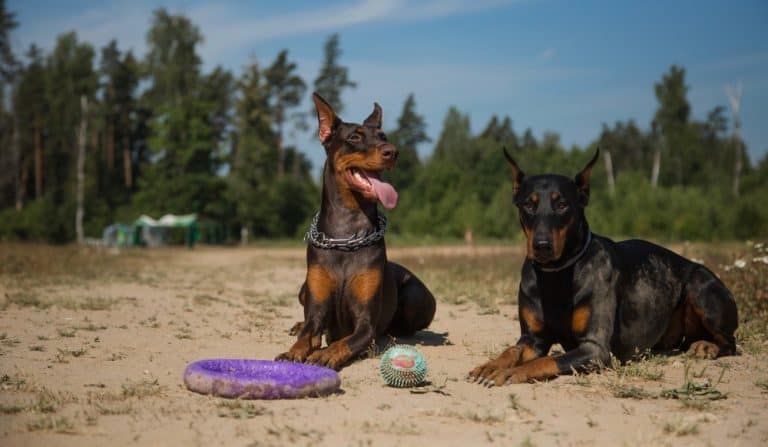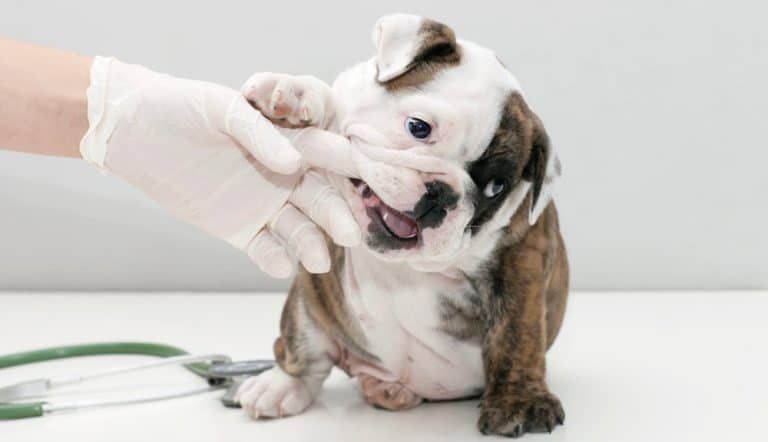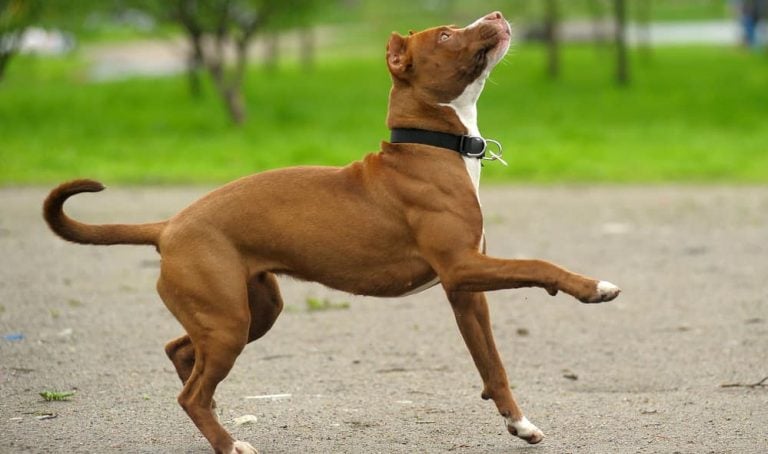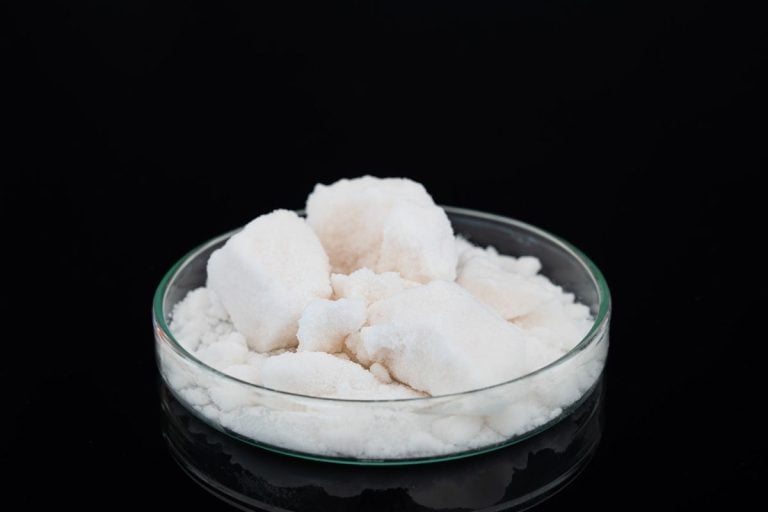Doberman Colors – Coats, Markings & Pictures
Dobermans are amazing dogs partly because loyalty is one of their most defining characteristics. They are also very alert and protective of those they love, making them the perfect companion when trained.
Before you decide to add one of these precious pooches to your family, you should familiarize yourself with Doberman colors.
Dobermans come in a wide variety of colors, such as fawn and rust, black and rust, blue and rust, as well as red and rust, to name a few. They also have two variants which are European and American.
Doberman colors are created by two genes: the color dilution gene and the black color gene. From these two genes, breeders can achieve other combinations.
The American Kennel Club (AKC) recognizes only four combinations as a part of their standard. These are blue, red, black, and fawn with rust markings. The white color is also not seen as “standard.”
We have composed a detailed list of all the coat color Doberman varieties to make your choice easy.
A Brief Look at the Doberman
This energetic breed loves exercise and time spent at play with his favorite humans. As a dog owner, you can take your Doberman on brisk walks or hikes. This will have a positive impact on his health and well-being.
Their body is sleek, and most people know the Doberman as a black dog with brown markings. They are considered a vigilant dog breed and ranks highly as one of the world’s best protection dogs. They are muscular, fast, and can grow to stand between 24 and 28 inches at their shoulders. Their reputation in the canine world is one of royalty.
When it comes to grooming these dogs, the Doberman doesn’t need to be bathed very often but should have his nails trimmed at least once per month, and his teeth should be brushed regularly. A short bristled brush or even a grooming mitt will help keep his coat shiny and healthy.
Doberman Markings
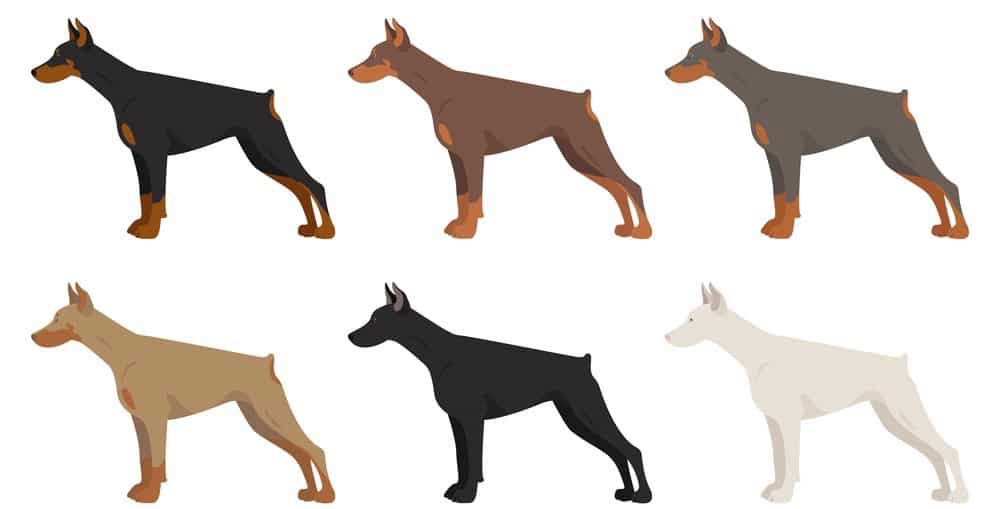
American Dobermans
The American Doberman’s coat is characterized by rust-colored patches that are sharply defined and have a lighter color when compared to the European.
These rust-colored markings are usually located over the eyes, chest, muzzle, and throat. They can also be found on the feet, legs, and below the tail.
Occasionally, they might have a tiny white spot (about ½ square inch) in the chest region. This does not appear on European Dobermanns.
European Dobermans
The European Doberman’s coat is also characterized by rust-colored patches that are sharply defined. These are known to be a bit darker than the American.
Their rust-colored markings are also located over the eyes, chest, muzzle, and throat. And just like the American Doberman, they appear on the legs, feet, and under the tail as well.
There are no small white markings on the European Doberman. It should be noted that European Dobermans have darker brown eyes.
Most New England Dobermans are owned and operated by a European Doberman breeder based in Massachusetts. These New England Dobermans are AKC registered and have a two-year health guarantee.
Doberman Colors
Black Rust
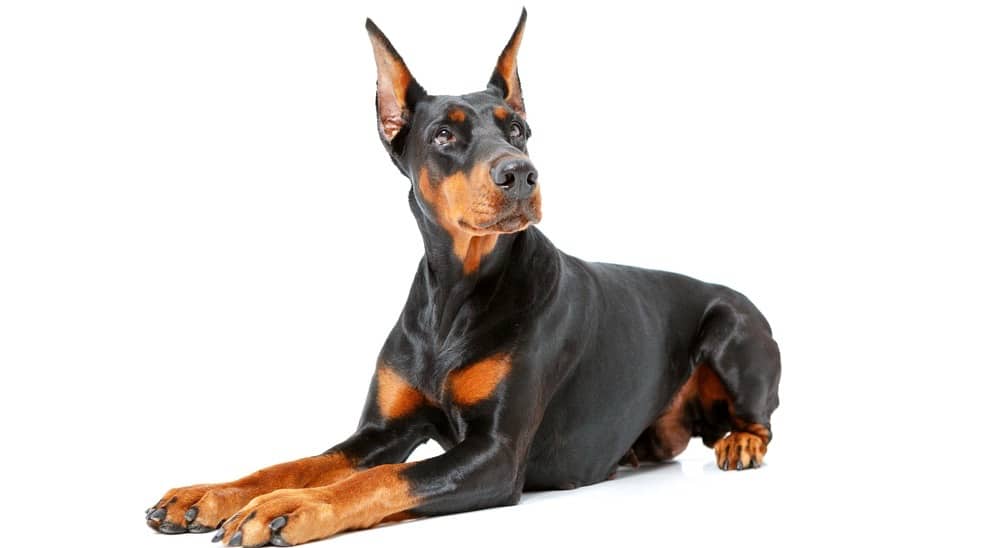
You may also hear this coat color being referred to as “black and tan,” which is standard for many other bicolor breeds. The Black and Rust coat color is achieved when the Doberman Pinscher expresses the black gene but doesn’t have the dilute gene.
This is the color people are most likely to think of when they imagine a Doberman Pinscher, which is a testament to how recognizable they are.
This is, without a doubt, the most popular coat color and the one most shown on television. They are also the easiest ones to acquire.
Of all Dobermans that exist, the majority of them are of the Black and Rust color coat. Because of this, it may be difficult to appoint a specific temperament to their coat color.
Since their coat is mostly black, you may notice that direct sunlight may be a problem for them, but most dogs within this breed have no problem with extreme temperatures.
This type of coat is accepted when it comes to the breed standard of the AKC.
Blue & Rust
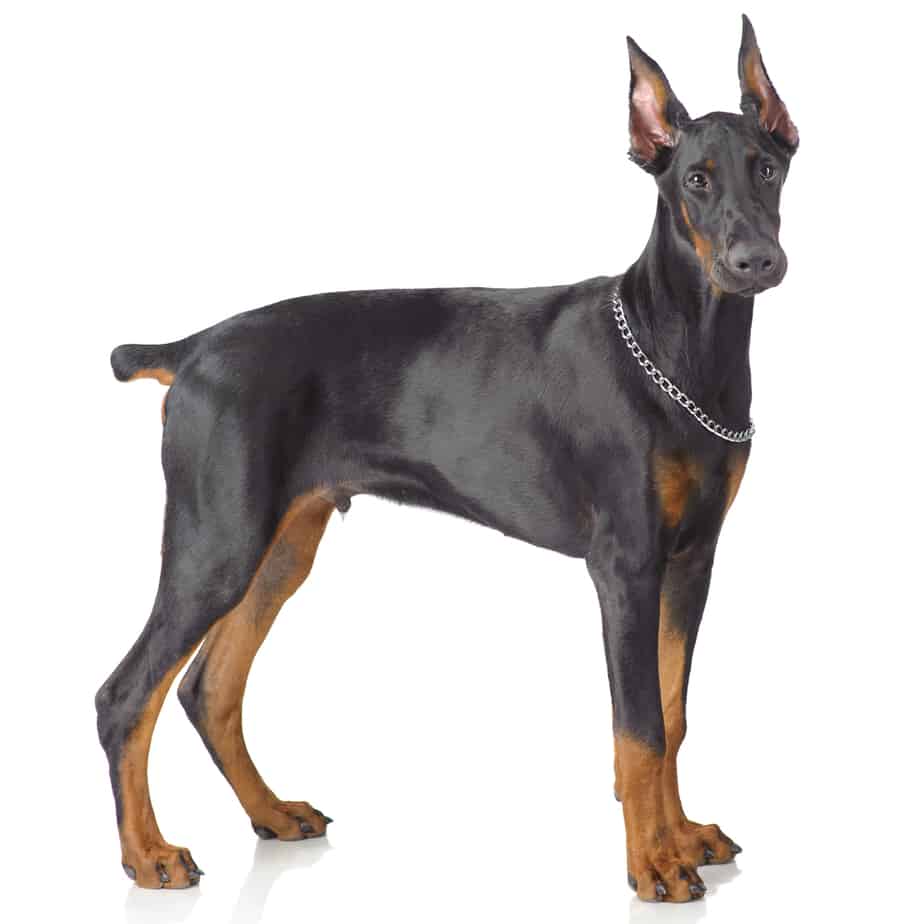
In Dobermans, when we have the black gene along with the dilute gene, a vivid gray color is produced, which looks almost blue.
The resulting puppies are categorized as blue and rust. Generally, Dobermans that are not black are seen as blue, but their blue-gray color saturation varies from charcoal to silvery.
This coat color is fairly rare because European kennel clubs do not include blue as part of their breeding standard for Dobermans.
Apart from a few skin infections, there is nothing to indicate that these types of Dobermans suffer a reduced level of health.
They can maintain AKC recognition even though they aren’t as common as the black and rust variety. The blue color is frequently mistaken for silver or slate gray, which is why this coat color is often referred to as gray Dobermans.
There is a lower contrast of the rust markings against slate blue than the black. This color gives the appearance of charcoal gray or silver and a dash of purple.
But remember that every Doberman is different, so the colors within this type also vary.
Red & Rust Doberman Color
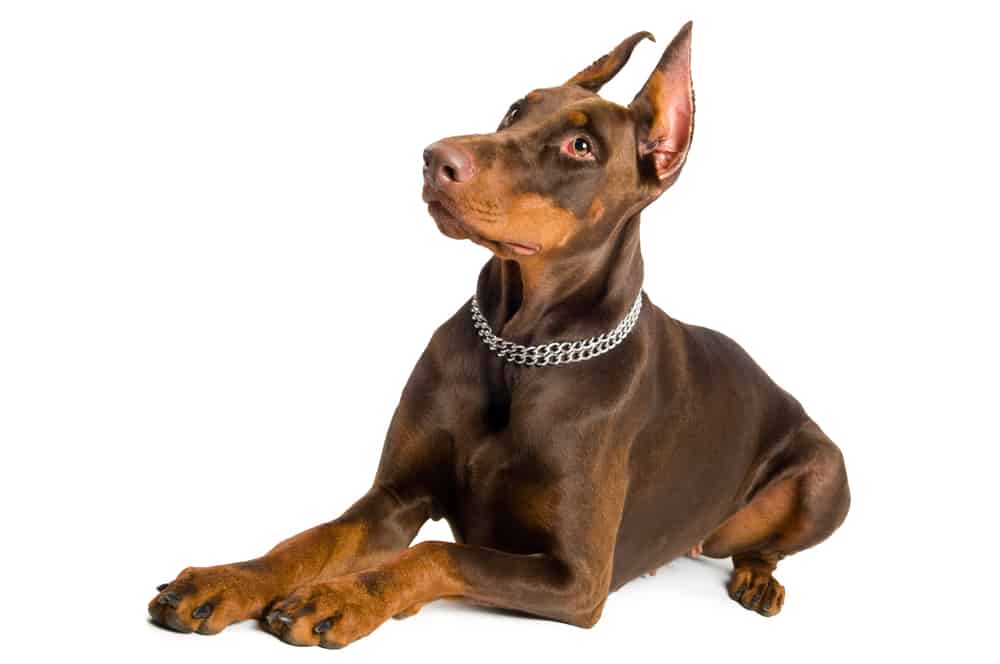
Whenever neither the dilute nor black genes are dominant, the red and rust color coat is created. It is also referred to as chocolate or brown, and it’s a very common coat, second only to the black and rust variety.
Their rust markings are more difficult to see on this coat type, but the boundaries are still defined.
It is sometimes said that Dobermans of this coat color are a bit more relaxed as well as friendlier to strangers; however, this is not substantiated by research.
This variety of Doberman also has tan markings located around the chest, muzzle, ears, bottom, legs, eyebrows, and below the tail.
This variety has a stunning color contrast due to the fact that the rust appears to be light brown, even though the black and rust contrast is considerably deeper.
The rust and red Doberman color is one of the AKC’s officially recognized standard color coats for the Doberman, and some owners would choose this color over the typical Doberman that is black and rust. This is because they are viewed as more unique.
Fawn (Isabella) & Rust
Dobermans of this variety mix a recessive black gene and a dominant dilute gene, producing a coat called the fawn. It is sometimes called the isabella and is the lightest coat the AKC will accept.
With this coat, the rust markings are only a little darker than the fawn color surrounding it, which creates a stunning ethereal effect.
This coat appears to be brown; however, these possess less of the red undertone than true reds. Just like other Dobermans, the tan markings are located around the chest, muzzle, ears, bottom, legs, eyebrows, and below the tail.
Nevertheless, it is a bit hard to notice due to the fact that the two colors are kind of similar; therefore, the contrast is understated.
The European dog shows do not accept the fawn and rust coat color and have a higher incidence of skin rashes than the other dilute variety.
The Isabella is said to receive their name from the Spanish Princess, Isabella, daughter of King Phillip II.
All Black Doberman Color
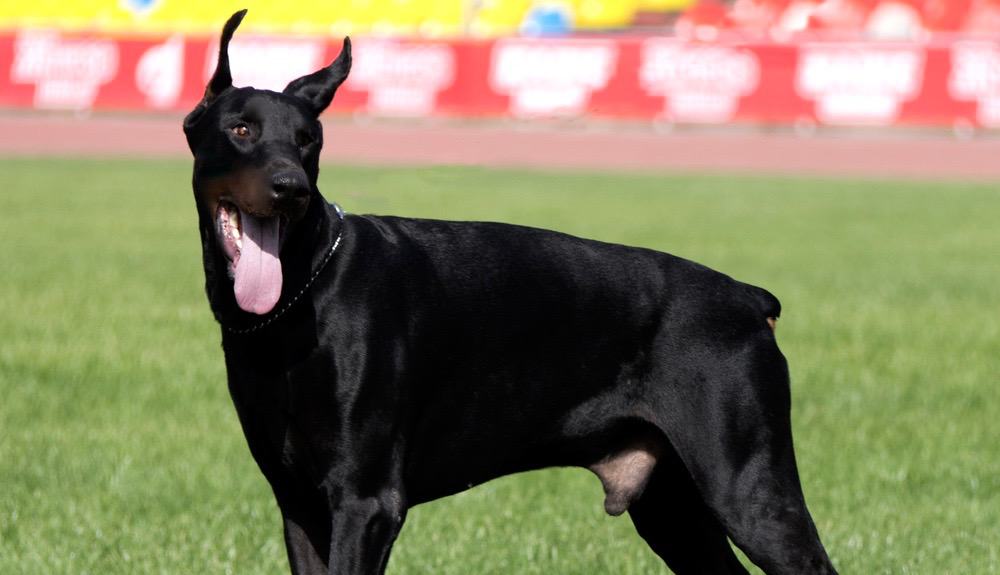
With black Dobermans, so much black pigment is produced that all the rust markings are overpowered and erased to create a solid black coat color.
Pure black is a rare type of coat that is also said to suffer some health problems; however, the black Doberman is subject to many skin issues like the white variety.
It is seen as unethical to breed a solid black Doberman, which is not as popular as the black and rust coat color.
They are also referred to as “melanistic Dobermans” because they don’t possess the typical rust markings, and the AKC does not recognize them as standard.
Some irresponsible breeders may intentionally breed these dogs to have them marketed as rare or exclusive to earn more profit from an uninformed potential Doberman owner.
Typically, the Doberman breeder who mates their dogs to create exclusive pups doesn’t pay attention to the overall health of these pups.
Do your best to avoid breeders who engage in these unethical practices as they create suffering in these animals without considering the long-term impact on the dog and the people they are sold to.
White
The white Doberman is a totally white variety that doesn’t have the typical rust markings, and on the rare occasions that they do, they will be white patches, with the rest of the coat appearing ivory or cream.
Because white dogs only produce small amounts of pigment, they are susceptible to a wide range of health problems, such as photosensitivity causing poor eyesight, skin cancer, and cracked skin.
This makes the white Doberman variety a bit controversial. So much so that the AKC recommends that the public shouldn’t trust breeders who continually mate using Dobermans that are white.
White Dobermans are said to be the result of inbreeding which caused them to be partially albino. They actually look beautiful, but many people tend to stay away from them because of the many health issues that persist throughout their lives.
These health issues, such as poor eyesight, lead to behavioral issues because these dogs develop anxiety because they have trouble seeing their environment.
The anxiety causes them to lash out aggressively and even bite their human. So they are prohibited in many countries.
It is no surprise that the AKC does not accept them as a part of their official standard classification and is also working to discourage breeders from creating them.
Albino
Unlike the white Doberman, which produces pigment but in small amounts, the albino Doberman has red eyes and no pigmentation at all. This is because they don’t have the gene that enables them to produce pigmentation.
They are considerably more white in color than the partially albino (white) Dobermans. A great way you can tell the difference between these two is to examine the eyes.
If they have pink or red eyes, they are full albino, while blue eyes mean that they are a white or partial albino Doberman.
Authentic albinos are rare and only exist due to a genetic mutation known as tyrosinase. Full albinos cannot produce blue eyes since that requires some form of pigmentation.
A Doberman breeder who advertises Dobermans as true albinos is not telling the truth because they usually have blue eyes.
A full albino Doberman is typically affected by similar health issues as their white-colored counterparts. These issues include cancerous skin tumors, susceptibility to sunburns, poor eyesight, and photosensitivity. They may also suffer from poor-quality fur and numerous skin problems.
Melanistic Blue
There are also rare Doberman colors like melanistic blue. A melanistic blue Doberman is gray, fully gray, all-gray, all-blue, charcoal, or purple.
A melanistic Doberman with blue has a genetic mutation that causes an overproduction of melanin and the color dilution gene. This leads to a dog that appears to be blue or gray. It is similar to a melanistic black Doberman, but the color is more diluted. This coat color is incredibly rare.
These dogs can cost between $700 and $4,000. Due to the rarity of this coat color, some breeders breed siblings as a way to keep the rare color, but this can cause the dog to be in poor health.
This color of Doberman Pinscher is considered very controversial among Doberman enthusiasts and professionals.
Melanistic Fawn
Melanistic fawn is also known as an all-fawn Doberman. Like the previous steel blue Doberman colors, this one also has the color dilution gene. It closely matches the color of a deer. This Doberman color is also incredibly rare and, again, is prone to improper breeding practices just so breeders can continue to produce this rare color.
Melanistic fawn is also another controversial and rare Doberman color produced often by cross-breeding and is then claimed by some to be full-blooded Dobermans.
How Do Doberman Color Genetics Work?
In Dobermans, there are two genes responsible for base coat colors. These are the dilute gene and the black pigment gene.
As the name suggests, the black pigment gene is responsible for creating a black pigment in the coat, and the dilute gene is responsible for diluting the pigment.
There are four ways that these genes can combine to create the four different colors officially recognized by the AKC for Dobermans.
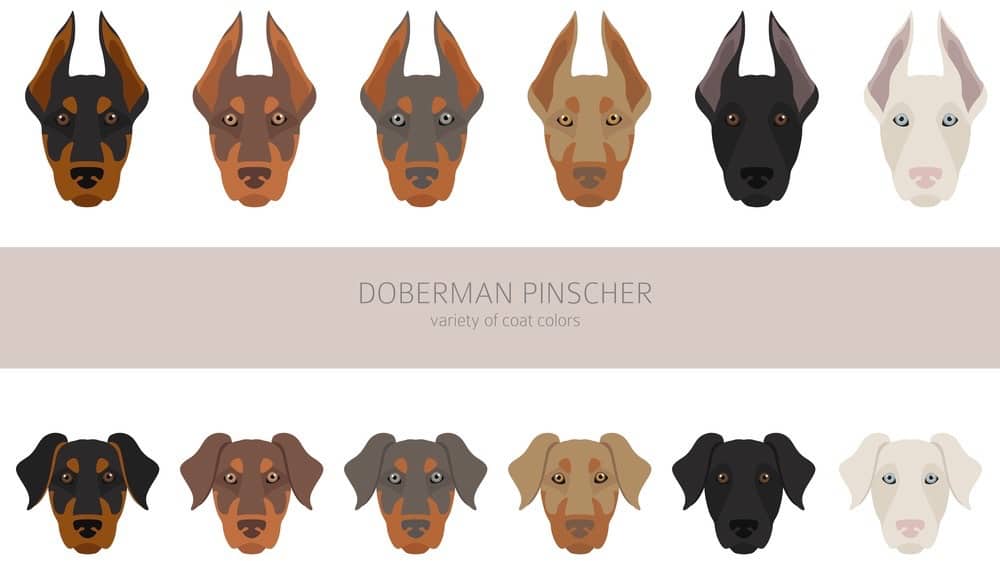
Few breeding pairs create offspring with coat colors that overpower their rust markings by either diluting the color to a lighter tone or near-white or darkening them to black.
It’s a little-known fact that all Dobermans possess the gene for markings of a rust color. Both Europeans and Americans have standards that they accept when it comes to rust marks.
But they both agree that the outlines should be clear and visible on all four of the paws, with two clear marks on the chest, throat, bottom of the tail, muzzle, and over the eyes.
What Is The Most Common Doberman Color?
Hands down, the most common color for the Doberman breed is the black and rust variety. They also typically have the least health problems.
Of all Dobermans that exist, most of them are of the black and rust color coat. Because of this, it may be difficult to appoint a specific temperament to their coat color.
Since their coat is mostly black, you may notice that direct sunlight may be a problem for them, but most dogs within this breed have no problem with hot temperatures.
This is the color people are most likely to think of when they imagine a Doberman. This is the one most shown on television, and they are also the easiest of all to get your hands on.
What Is the Most Popular Doberman Color?
Black and rust colored Dobermans are by far the most popular. This is according to a survey conducted by Doberman’s Den. Approximately 62% of the people voting chose black and tan as their favorite colors, and red and rust came in second with 24% of the votes for popularity and appeal.
Rare Doberman Colors
The fawn color is the rarest of four varieties of the officially recognized standard of the AKC. It is estimated that less than 10% of all Dobermans possess the fawn color, although it is stunningly beautiful to many. This is maybe because of show ring restrictions.
Dobermans of the fawn variety mix a recessive black gene and a dominant dilute gene, producing a coat called the fawn.
With this coat, the rust markings are only a little darker than the fawn color surrounding it, which creates a beautiful appearance.
Like other Dobermans, the tan markings are located around the chest, muzzle, ears, bottom, legs, eyebrows, and below the tail.
However, it is a bit hard to notice because the two colors are similar; therefore, the contrast is less seen.
In most cases, the fawn-colored Doberman is not easy to breed, even though it is definitely quite rare. Imagine what irresponsible breeders will do, knowing that there are very few specimens of this certain color in a dog breed that they wish to preserve.
The Relationship Between Coat Color And Doberman Health & Behavior
Research concerning the relationship between coat color and health and behavior is scarce. However, we have evidence of this relationship in certain dog breeds. For example, we can look at Dobermans with pigmentation issues like partially white and full albinos.
White Dobermans only produce small amounts of pigment, so they are susceptible to a wide range of health problems, such as photosensitivity causing poor eyesight, skin cancer, and cracked skin.
These health issues, such as poor eyesight, lead to behavioral issues because these dogs develop anxiety because they have trouble seeing their environment.
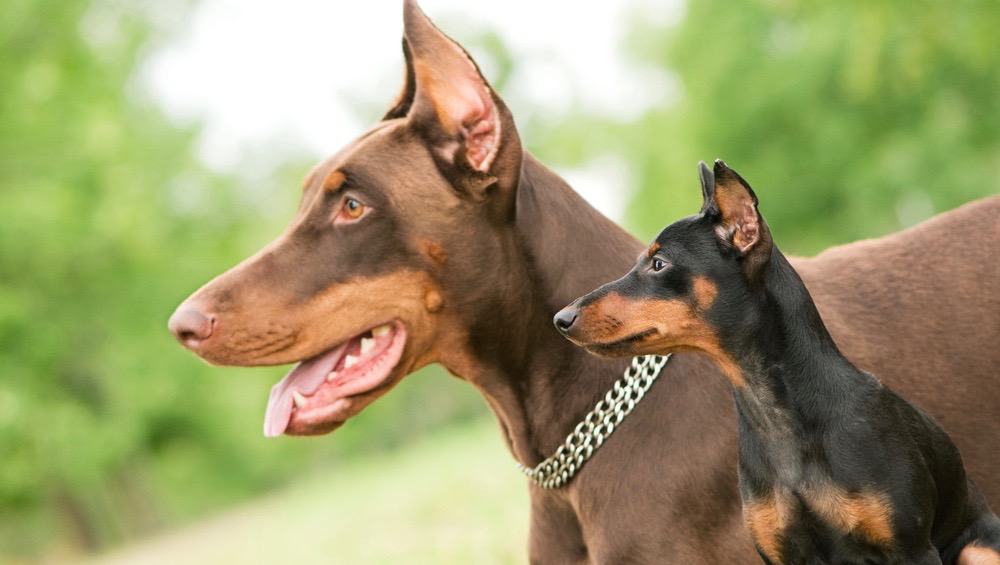
The anxiety causes them to lash out aggressively and even bite their human. So they are prohibited in many countries.
In this case, there is no evidence that the coat directly affects behavior, but it indirectly causes the dog to have behavioral problems.
Another example that we can look at are authentic albinos. They are a very rare breed and only exist due to a genetic mutation known as tyrosinase. Full albinos cannot produce blue eyes since that requires some form of pigmentation.
Full albino Dobermans are typically affected by similar health issues as their white-colored counterparts.
These issues include cancerous skin tumors, susceptibility to sunburns, poor eyesight, and photosensitivity. They may also suffer from poor-quality fur and numerous skin problems.
Black Doberman Color & Black Dog Syndrome (BDS)
Solid black Dobermans are rare, but they do exist. You may also hear them being called melanistic Dobermans. These black Dobermans do not have the typical rust color patches on their coats.
It is not advised that they are bred and don’t meet the AKC’s official breed standards. In all dog breeds, those with solid black coats are seen as less desirable, which is called Black Dog Syndrome.
Some people do not believe that Black Dog Syndrome exists because of the lack of research data available to support the concept. However, we can gain some insight from statistics on dogs with black coats.
According to the Los Angeles Animal Services Department, in 2008, 27% of the dogs they collected in the last year had mostly sable coats. This trend mirrored their adoption statistics, which state that only 28% of the adopted animals had mostly black coats.
All in all, these statistics have exposed useful information about the perception of black pups.
Doberman Coat Color vs Price
Some Doberman dogs are raised as pets with no genealogy. These puppies usually come at a cheaper cost, around $800 to $1200.
This is because they are not registered pups and have no ACK genealogy and documentation. They are typically sold in pet shops, or you may see them on advertising websites.

Dobermans that are fully registered and purebred go at a considerably higher price as they are usually sold at breeding farms for professional Dobermans. Their price can be around $1200 to $2800 for puppies of a normal genealogy.
However, for totally purebred puppies, you may have to pay about $2800 to $5000. These pups would be born at reputable breeding farms and have a beautiful genealogy.
It may cost you even more to own a Professional Doberman for their purpose. Dobermans are sometimes bred to be guard dogs because of their strong, big, and loyal characteristics.
The rarer coat colors of Dobermans usually go at a higher price simply because of demand and supply and because some rarer ones are more difficult to create.
For example, some breeders charge a hefty price for white Dobermans. The Fawn colors are a favorite and are pretty expensive as well. In all cases, the dog’s health should be considered as well.
Do Dobermans Change Their Coat Color As They Age?
There has been no substantial evidence to support Dobermans changing color over time, but many owners report a change in coat color as their puppies get older.
However, this change is never drastic, even if it comes from diluted litter. They typically lose puppy coats as they age, but their coat will not completely change.
There have also been reports of facial markings changing with age. However, this may be because the shape of your Doberman is changing as they tend to lose their puppy-like features.
Additionally, there have been rare instances where a Doberman suffers from vitiligo. This is a condition where there is a loss of pigmentation in certain skin areas, resulting in irregular white spots. These spots are generally harmless and feel like normal skin.
American vs European Doberman
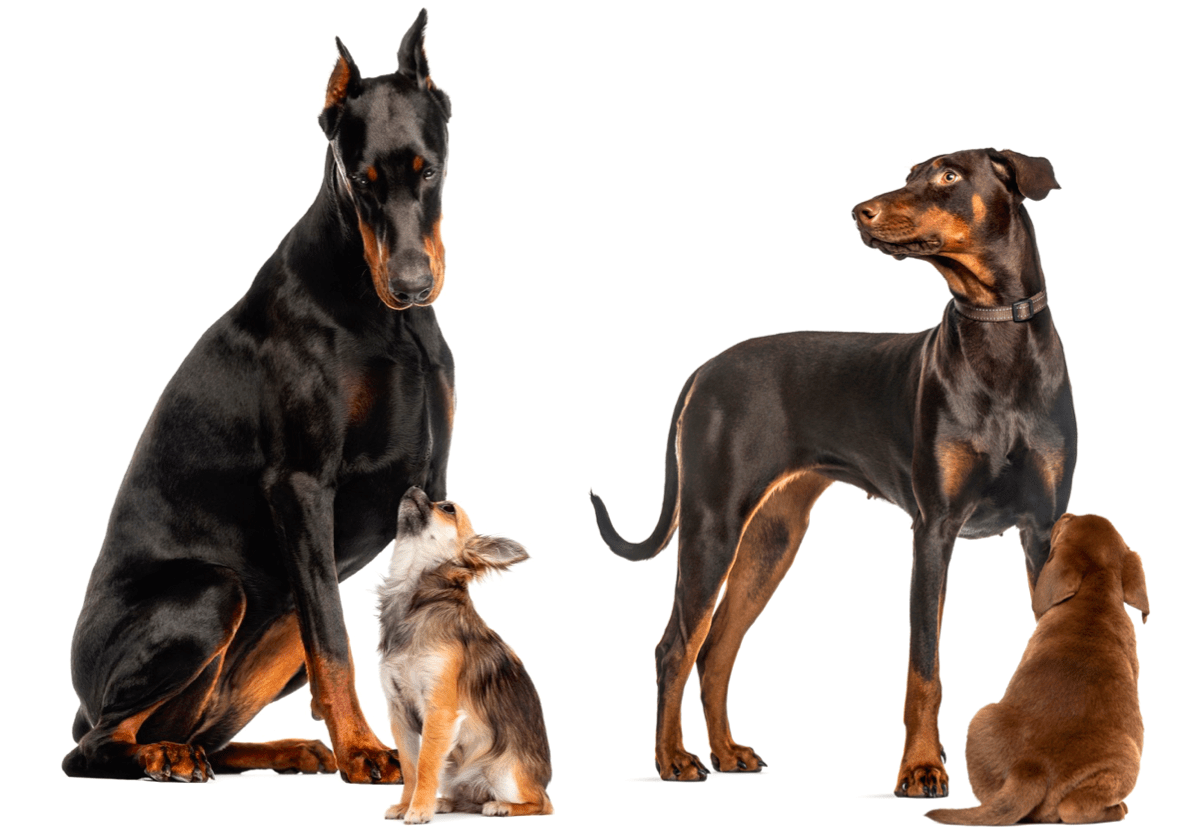
There are a few key differences between the European and American Doberman.
American Dobermans are elegant, sleek dogs with the ideal temperament to be great family pets. On the other hand, the European Doberman is a bit bigger and more muscular.
They make better working dogs because of their alertness and high drive.
Even though these two breeds appear the same to many people who aren’t intimately familiar with Dobermans, there are a few key areas to look for when it comes to telling the difference. There are also major differences in temperament that are important to know.
The physical build is probably the most noticeable difference between the two Doberman types. The AKC has placed a considerably broad range for the acceptable weights of the American Doberman.
On the other hand, the FCI has placed a particularly tight weight range. This makes the European Doberman persistently heavier than the American Doberman.
Even though the color differences of both Doberman types aren’t as obvious as other physical comparisons, they can be simply seen whenever both dogs are placed next to each other.
Perhaps the most striking variance is that the American variety has less pigment than the European version leading to a darker coat with deeper colors.
European breeders don’t particularly like the variety of elegance seen in modern American dogs because they don’t seem to have the “working dog” characteristics.
Because of this, the international champions are more masculine and a bit heavier dogs. They also are a bit more stable and confident with a “working dog” attitude.
On the other hand, American breeders see European Dobermans as overly assertive, big, coarse, thick-boned, too masculine, and heavy.
And European breeders see the American Doberman as finely boned, sensitive, feminine, timid, delicate, without the confident disposition needed to be a good working dog.
Final Words
It is a matter of preference when it comes to selecting the color of your Doberman puppy. However, it is important to keep in mind crucial factors like health concerns that tend to affect Dobermans of a particular coat variety. This coat variety could sometimes affect your dog’s temperament.
Be aware of these things before making your decision. It is better to not restrict oneself to a certain color and instead look at issues such as health.
Dobermans have short fur, making it easy to groom them. Additionally, because their coat is mostly dark, they always appear clean. Many owners like the fact that they hardly need to spend money on grooming.
They are a fierce dog breed that is always willing to chase, defeat, and swiftly attack opponents.
They are brave as they are eager to oppose stronger and larger threats to safeguard the family to which they belong. Dobermans are also reliable and loyal.

